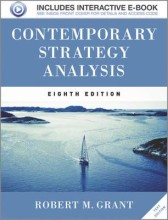Technology-based Industries and the Management of Innovation 12 Global Strategy and the Multinational Corporation 13 Diversifi cation Strategy 14 Implementing Corporate Strategy: Managing the Multibusiness Firm 15 External Growth Strategies: Mergers, Acquisitions, and Alliances 16 Current Trends in Strategic Management
13 important questions on Technology-based Industries and the Management of Innovation 12 Global Strategy and the Multinational Corporation 13 Diversifi cation Strategy 14 Implementing Corporate Strategy: Managing the Multibusiness Firm 15 External Growth Strategies: Mergers, Acquisitions, and Alliances 16 Current Trends in Strategic Management
What are the main differences between corporate and new venture management?
 New: Flexible, high uncertainties, entrepreneurship and getting resources is important. Lacking experience but a lot of adapting. Low investment and likely profit
New: Flexible, high uncertainties, entrepreneurship and getting resources is important. Lacking experience but a lot of adapting. Low investment and likely profitCorporate: Not flexible, a lot of resources but also a lot of negotiation and compromises (checks), less risk but also less profitable. High investment and likely profit
Is corporate venturing a good idea? Explain
Problem: It fails in re-integrating the new businesses with the established organization. Need to attend to both incubation and integration
Considering organizational structures, markets and technologies, when would you chose internal development, joint venture, corporate venture or acquisition?
- Higher grades + faster learning
- Never study anything twice
- 100% sure, 100% understanding
What are today's trends in organizations? What do they imply?
Increased customization: customer specific solutions in smaller market segments.
Increased knowledge content: more specialist knowledge needed in more fields
Increased uncertainty: regarding technologies and market behavior
Need for more:
Heterogeneity
Ambidexterity
Differentiation and integration
What do we mean with organizing for innovation and efficiency?
Leading to: Separate new business development units and set-up of autonomous firms.
This does not solve the complete problem for innovation and efficiency:
New ideas may surface, but they rarely grow and prosper (due to organizational politics, fear of cannibalism, not worth focusing on due to small volumes)
Synergies between old and new businesses are not realized (unawareness of the demands from sales, manufacturing and supply. Reinventing the wheel).
Which integration mechanisms can be used to handle tensions between innovation and efficiency?
– Tap into individual creativity by creating space/time for innovation
– Increased holistic understanding through job rotation
– Induce marketing thinking into the R&D department
– Wider or shared management responsibilities
– Creating alternative channels for innovation, e.g. idea ombudsman
– Create acceptance at top management for new initiatives
– Get customer and user input, e.g. through the establishment of communities
What are differentiated and integrated companies, why are they most successful?
Integration: Bringing specialized people together, achieving unity of effort among the differentiated subsystems.
High differentiation and high integration = high performance!
Success because:
Benefits of specialization: a lot of knowledge and capabilities in a certain segment / technology.
Benefits of integration: Working towards the same overall goals.
Combined: Specialists working towards same goals instead of sub optimization of subsystems
Differentiation and integration is beneficial. Integration comes with effort: costs. Discuss the ladder of mechanisms for horizontal linkage and coordination. (y/x axes) What is the issue/trade-off?
X-axis: Cost of coordination in time and human resources
Issue: More integration than required is redundant and thus a waist. Less integration than needed leads to sub-optimization inefficiencies.
Ladder: Information systems, direct contact, task forces, full-time integrators, teams
How global should R&D be? What is the trade-off between concentrating R&D and distributing R&D?
Global integration:
Efficiency
Cost benefits of scale
Learning benefits: exploit international differentiation in culture and tackle problems in various ways and become more effective in operations.
National adaption/differentiation:
Adaption to customer need and market demands
What does Porter's National diamond discusses?
 Porter's National Diamond discusses a country's competitive advantage within in a particular sector.
Porter's National Diamond discusses a country's competitive advantage within in a particular sector.Factor conditions:
Highly specialized resources that are "home-grown". E.g. Italy's automation due to restrictive labor laws.
Related and supporting industries:
Competitive advantages tend to be associated clusters of industries (Denmark wind power)
Demand conditions:
Demand conditions in a domestic market provide the primary driver of innovation and quality improvement. E.g. Germans and cars
Strategy, structure and rivalry:
Higher competition in countries drives innovation, efficiency and competitive advantage. Japanese cars/camera's
What are main issues in distributed R&D?
• Geographicalandorganizationaldistances
• DataManagement
• Standardization – local adaptation
• Culture:
– Universalismvs.Particularism
– Individualismvs.Collectivism
– Egalitarianvs.Hierarchical
– Neutralvs.Affective Relationships
– Achievementvs.Ascription
– Perception of time
– Internalvs.ExternalControl
• Localpatriotism
• Not-Invented-Here
• Insufficientredundancyofknowledge
What are the three areas of development in the multinational company?
American international: use US based capabilities in foreign countries --> were the primary resource of competitive advantage. Also, economies of scale.
Japanese challenge: R&D in japan, overseas sells and logistics --> efficient, low adaption do not know real market.
What does a Transnational Corporation do? What is a challenge for management?
By combining the both, he can get the benefits of global integration: economies of scale, learning benefits, efficiency.
And also of local differentiation: Serve the customer + local specialization
Challenge for management: Highly complex management role that coordinated relationships among units in a highly flexible way.
The question on the page originate from the summary of the following study material:
- A unique study and practice tool
- Never study anything twice again
- Get the grades you hope for
- 100% sure, 100% understanding
































